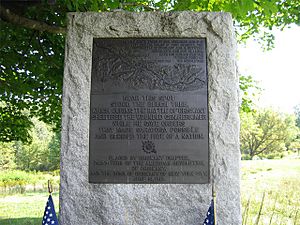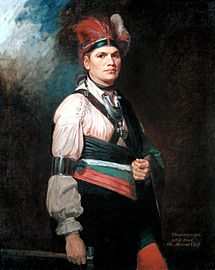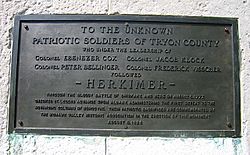Battle of Oriskany facts for kids
Quick facts for kids Battle of Oriskany |
|||||||
|---|---|---|---|---|---|---|---|
| Part of the American Revolutionary War | |||||||
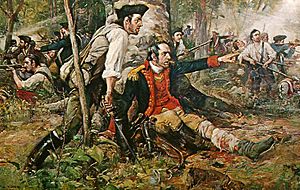 Herkimer at the Battle of Oriskany Painting by Frederick Coffay Yohn, c. 1901, now in the public library in Utica, New York |
|||||||
|
|||||||
| Belligerents | |||||||
|
|||||||
| Commanders and leaders | |||||||
Joseph Brant Governor Blacksnake |
|||||||
| Strength | |||||||
| 720–740 militia 60–100 Indians |
500 regulars, militia and Indigenous | ||||||
| Casualties and losses | |||||||
| 385 killed 50 wounded 30 captured |
Indigenous: 65 killed or wounded British: 7 killed, 21 wounded, missing, or captured |
||||||
The Battle of Oriskany was a very important and fierce fight during the American Revolutionary War. It happened on August 6, 1777, near Oriskany, New York. This battle was one of the bloodiest of the war.
In this battle, a group of American soldiers was marching to help Fort Stanwix, which was under attack. They were ambushed by Loyalists (Americans who supported the British) and their Indigenous allies. What made this battle special was that most of the fighters were Americans. Patriots (Americans fighting for independence) and their Oneida allies fought against Loyalists and their Iroquois allies. There were also some German soldiers, called Hessians, fighting with the British side.
The Patriot force was led by General Nicholas Herkimer. He had about 800 local soldiers, called militia, and 60 to 100 Oneida warriors. The British commander, Barry St. Leger, sent a group to stop them. This group included German light infantry, Sir John Johnson's Loyalist soldiers, and many Indigenous allies, especially Mohawks and Senecas. In total, they had at least 450 men.
The Loyalists and Indigenous fighters set up their ambush in a small valley near Oriskany. General Herkimer was badly wounded during the fight. The Patriots lost about 451 men, while the Loyalists and their allies lost about 150. The outcome of the battle is still debated. Even though the Loyalists seemed to win, their spirits were hurt when a group from Fort Stanwix attacked and looted their camps.
This battle also started a war among the Iroquois nations. The Oneida warriors, led by Colonel Louis and Han Yerry, sided with the Americans. Most other Iroquois tribes, like the Mohawks and Senecas, allied with the British. This division caused great sadness among the Iroquois people. The battle site is now a National Historic Landmark and has a monument.
Contents
Why the Battle of Oriskany Happened
British Plan to Control New York
In June 1777, the British Army launched a major attack from Quebec. General John Burgoyne led the main attack south. His goal was to split New England from the other American colonies. He wanted to control New York's Hudson Valley.
A second British force, led by Lt. Colonel Barry St. Leger, was part of this plan. St. Leger's job was to move down the Mohawk Valley. He was supposed to meet Burgoyne's army near Albany.
St. Leger's March and Fort Stanwix
St. Leger's group had about 1,800 men. They were a mix of British soldiers, German Hessians, Loyalists, and Indigenous warriors from several tribes. They traveled by river and lake to reach the Oneida Carry in Rome, New York.
Their first big task was to attack Fort Stanwix. This fort was a Continental Army outpost that guarded an important portage (a place where boats had to be carried over land). St. Leger's forces began to besiege (surround and attack) the fort.
Preparing for the Fight
Herkimer's Call to Arms
Nicholas Herkimer, a leader in Tryon County, heard about the British attack. On July 17, he warned people to be ready to fight. On July 30, his Oneida allies told him the British were very close to Fort Stanwix.
Herkimer then called for everyone to gather their weapons. About 800 local militia members joined him. These were mostly farmers of German descent, and they weren't very well trained. They started their march on August 4.
Oneida Allies and Messages to the Fort
On August 5, Herkimer's force camped near the Oneida village of Oriska. Some militia members left because they were not used to such a difficult march. However, Herkimer's group grew stronger with 60 to 100 Oneida warriors. These warriors were led by Han Yerry, who strongly supported the American cause.
That evening, Herkimer sent three men to Fort Stanwix. They carried messages for Colonel Peter Gansevoort, the fort's commander. Gansevoort was supposed to fire three cannon shots to show he got the message. Then, he was to send soldiers out to meet Herkimer's approaching group. But the messengers had trouble getting past the British lines. They didn't deliver the message until the next morning, after the battle had already begun.
British and Indigenous Preparations
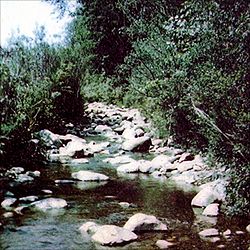
On August 5, St. Leger learned that Herkimer was coming. A messenger from Molly Brant told her brother, Joseph Brant. Joseph Brant was a Mohawk leader who led many Indigenous warriors with St. Leger.
St. Leger immediately sent some light infantry soldiers to watch Herkimer's position. Early the next morning, Joseph Brant followed with about 400 Indigenous warriors and Butler's Rangers. Many of these Indigenous allies had muskets, while others carried tomahawks and spears.
The Battle Begins
Herkimer's Difficult Decision
On the morning of August 6, Herkimer held a meeting with his officers. He wanted to wait because he hadn't heard the cannon signal from the fort. But his captains pushed him to keep going. They even accused him of being a Tory (another name for a Loyalist), because his brother was fighting with St. Leger.
Herkimer was upset by these accusations. He finally gave in and ordered his men to march towards Fort Stanwix.
The Ambush at the Ravine
About six miles (9.6 km) from the fort, the road went down into a deep, marshy valley. There was a small stream at the bottom. Seneca chiefs Sayenqueraghta and Cornplanter chose this spot for an ambush.
The Loyalist soldiers hid behind a nearby hill. The Indigenous allies hid on both sides of the valley. Their plan was for the Loyalists to stop the front of Herkimer's group. Then, the Indigenous warriors would attack the long line of soldiers.
Around 10 a.m., Herkimer's men marched into the valley. Herkimer was on horseback near the front.
The ambush started too early. The Indigenous warriors opened fire on the back of Herkimer's column. This caught the Americans completely by surprise. Colonel Ebenezer Cox, who was leading the first regiment, was shot off his horse and killed right away. Herkimer turned his horse to see what was happening. He was hit by a bullet that shattered his leg and killed his horse.
Several of his officers carried him to a beech tree. They wanted him to get away from the danger. But Herkimer bravely said, "I will face the enemy." He calmly sat leaning against the tree, smoking his pipe. He gave orders and encouraged his men.
Fighting in the Ravine
Because the ambush started too early, some parts of Herkimer's column had not yet entered the valley. Many of these men panicked and ran away. Some Indigenous fighters chased them, leaving dead and wounded soldiers for miles. After only 30 minutes of fighting, about half of Herkimer's men were no longer able to fight.
Some of the attackers who didn't have muskets waited for an opponent to fire. Then, they would rush forward and attack with a tomahawk. Mohawk Chief Louis Atayataronghta was fighting with Herkimer's men. He shot one of the enemies who was very accurate with his shots. He said that "every time he rises up he kills one of our men."
Regrouping During a Storm
Herkimer's men eventually fought their way out of the valley. They reached higher ground to the west. John Johnson was worried about how tough the militia was. He went back to the British camp and asked St. Leger for more soldiers. He returned with 70 men.
A thunderstorm then caused a one-hour break in the fighting. During this time, Herkimer gathered his militia on the higher ground. He told his men to fight in pairs. One man would fire and reload, while the other waited. The second man would only fire if attacked. This way, they would always have at least one loaded weapon. This helped reduce the success of tomahawk attacks.
Tricking the Patriots
During the thunderstorm, Ranger John Butler questioned some captured American soldiers. He learned about the three-cannon signal. When Johnson and his reinforcements arrived, Butler convinced them to turn their coats inside out. This made them look like a relief party coming from the fort.
When the fighting started again, Johnson and his Royal Yorkers joined the battle. But Patriot Captain Jacob Gardinier recognized the face of a Loyalist neighbor. The fighting continued for a long time, often hand-to-hand. Many of the men fighting were actually neighbors.
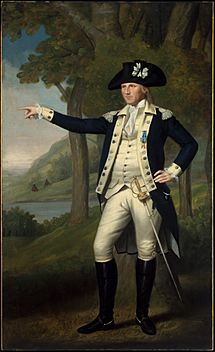
Attack from Fort Stanwix
Herkimer's messengers finally reached the fort around 11 a.m. Colonel Gansevoort then organized the attack from the fort. Lieutenant Colonel Marinus Willett led 250 men out of the fort. They raided the enemy camps, which were almost empty. They drove away the few British and Indigenous people left there, including women. They also took four prisoners.
The Americans stole blankets and other personal items from the Indigenous camps. They also raided John Johnson's camp. They took his letters and other writings, including a letter to Gansevoort from his fiancée.
One of the Indigenous warriors guarding the camps ran to the battlefield. He warned his fellow warriors that their camps were being raided. They stopped fighting with cries of "Oonah, oonah!" This was the Seneca signal to retreat. They rushed back to their camps to protect their women and belongings. This forced the smaller number of German and Loyalist fighters to also leave the battle.
What Happened After the Battle
Patriot Losses and Retreat
Herkimer was badly wounded, and many of his officers were killed. The remaining American soldiers retreated to Fort Dayton. Herkimer was carried from the battlefield. His leg was amputated, but the surgery did not go well. He died on August 16.
The Indigenous fighters took their dead from the battlefield the next day. But many dead and wounded Patriots were left behind. When Benedict Arnold's relief column marched through weeks later, they were shocked by the terrible sight and smell.
General Philip Schuyler heard about the retreat from Oriskany. He quickly sent more help to the area. Arnold's relief column arrived at Fort Stanwix on August 21. Arnold sent messengers into the British camp. These messengers tricked the British and Indigenous attackers into thinking Arnold's force was much larger than it was. Because of this, the British and their allies gave up their attack on the fort and left.
Loyalist Actions
Loyalist John Butler was promoted to Lieutenant Colonel for his part in the battle. He was allowed to create a new group of soldiers called Butler's Rangers. After the siege of Fort Stanwix ended, some Loyalists went back to Quebec. Others joined Burgoyne's campaign on the Hudson River.
Impact on Indigenous Tribes
The day after the battle, Joseph Brant and Seneca chief Sayenqueraghta wanted to keep fighting. They suggested chasing the Patriots downriver. But St. Leger refused.
This battle was the start of a war among the tribes of the Iroquois Confederacy. It was the first time they had fought against each other. The Mohawks, Senecas, Cayugas, and Onondagas sided with the British. Some Oneidas also allied with the British. The Iroquois in St. Leger's camp decided to send a "bloody hatchet" (a symbol of war) to the Oneidas who allied with the Patriots.
Later, Brant's Mohawks attacked and burned the Oneida village of Oriska. In return, the Oneidas looted the Mohawk strongholds of Tiononderoge and Canajoharie. They also raided the Fort Hunter Mohawks. This caused most of the remaining Mohawks in central New York to flee to Quebec.
Who Won the Battle?
The Battle of Oriskany was one of the bloodiest battles of the war. About half of Herkimer's men were killed or wounded. About 15% of the British force also suffered casualties.
St. Leger said the battle was a victory for him because he stopped the American relief column. However, the Americans controlled the battlefield after the Indigenous fighters left. The British victory was also affected by the Indigenous allies' unhappiness after the battle. They expected the British to do most of the fighting. Instead, they were the main fighters in this battle. Also, they lost their personal belongings when the Americans raided their camps. This lowered their spirits and helped cause St. Leger's expedition to fail.
Remembering Oriskany
Blacksnake, a war chief of the Seneca nation, was interviewed many years later. He remembered, "I thought at that time the Blood Shed a Stream running down on the decending [sic] ground."
A monument was built in 1884 to remember the battle. Most of the battlefield is now part of the Oriskany Battlefield State Historic Site. This site was recognized as a National Historic Landmark in 1962. It was added to the National Register of Historic Places in 1966.
The town of Herkimer (town), New York and Herkimer County, New York are named after General Herkimer. The battle was also honored by the name of an aircraft carrier, USS Oriskany, launched in 1945. A postage stamp was also issued in 1977 to mark the battle.


